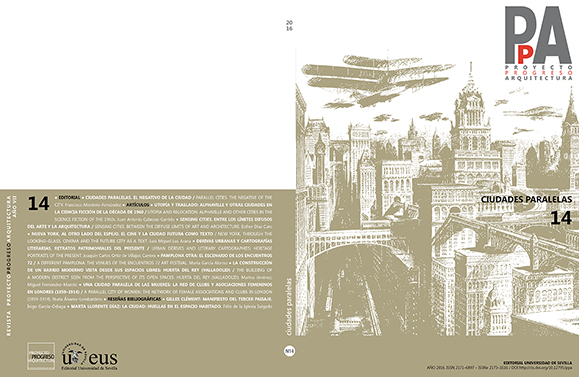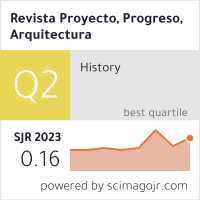UNA CIUDAD PARALELA DE LAS MUJERES: LA RED DE CLUBS Y ASOCIACIONES FEMENINOS EN LONDRES (1859–1914) / A parallel city of women: the network of female associations and clubs in London (1859–1914)
DOI:
https://doi.org/10.12795/ppa.2016.i14.07Palabras clave:
clubs, asociaciones sufragistas, Londres, mujeres, estudios de género, mapas / female clubs, suffragists associations, London, women, gender studies, mapsResumen
RESUMEN Entre mediados del siglo XIX y principios del XX la ciudad de Londres sufrió una radical transformación social y espacial convirtiéndose en una ciudad moderna. Entre estos procesos de transformación se encuentra la división de la ciudad en términos de género consecuente con la implementación progresiva de los códigos morales evangélicos imperantes en la sociedad de la época. No obstante, entre 1859 y 1914, un grupo de mujeres rompieron estas divisiones a través de distintos mecanismos de acción utilizados para reclamar tanto sus derechos como ciudadanas como un lugar en la esfera pública urbana. Entre estos mecanismos se encuentra la progresiva apertura de espacios de asociación como estrategia de infiltración en una ciudad exclusivamente masculina. El surgimiento de clubs y asociaciones femeninos consolidó una sólida red relacional que posteriormente eclosiona con las grandes marchas sufragistas en el espacio público a principios del siglo XX. A través de esta primera red de lugares se evidencia una ciudad paralela de las mujeres definida por unos mapas alternativos de la ciudad, que serían, no obstante, largamente marginados por la historiografía moderna.
SUMMARY Between mid-nineteenth and early twentieth century, London underwent a radical social and spatial transformation to become a modern city. A key part of this transformation process is a gendered division of the city related to a progressive implementation of evangelical moral codes prevailing in the society of that time. However, between 1859 and 1914, a group of women broke these divisions through different mechanisms of action to reclaim both a place in the urban public sphere and their citizen rights. Among these mechanisms, there is a strategy of infiltration in this male town that is implemented through a progressive opening of spaces of association. The progressive opening of women’s clubs and associations consolidated a solid relational network that subsequently is disclosed in large suffragette’s marches in the public space in the early twentieth century. Through this first network of places, a parallel city of women is evidenced and defined by alternative city maps, which, however, would be later long marginalized by modern historiography.
Descargas
Citas
Adams, Jad: Pankhurst, London: Life and Times. London: Haus Publishing, 2003.
Ainley, Rosa: New Frontiers of Space, bodies and Gender. London: Routledge, 1998.
Álvarez Lombardero, Nuria: “Hacia una Teoría del Patrimonio Social Urbano”. En Metalocus. Diciembre 2006, Nº 19, Madrid. 1998. pp.14–25.
Bradley, Ian C.: The Call to Seriousness: The evangelical Impact on the Victorians. New York: Macmillan, 1976.
Butler, Judith: Gender trouble, New York: Routledge, 1990.
Crawford, Elisabeth: Women´s suffrage movement: a reference guide, 1866–1928. London: UCL Press, 1999.
Daly, César (Ed.): Revue générale de l´architecture, (RGA), Nº 13, col. 57–58, Paris: Ducher et cie., 1855.
Daly, César: Revue générale de l´architecture et des travaux públics (RGA). Nº 1, 1840. col. 328.
Doughan, David y Gordon, Peter: Women, Clubs And Associations in Britain. New York: Taylor & Francis, 2006.
Fishman, Robert: Bourgeois Utopias. The Rise and Fall of Suburbia. New York: Basic Books, Inc. Publishers, 1987.
Foucault, Michel: History of sexuality. Vol. 1. London: Penguin, 1978.
Gandy, Frances; Perry, Kate; Sparks, Peter: Barbara Bodichon, 1827–1891. Cambridge: Girton college, 1991.
Harvey, David: “The Right to the City”. En International Journal of Urban and Regional Research. 2003, Vol. 27, Issue 4. pp.939–941.
Hayden, Dolores: The Grand Domestic Revolution. Cambridge Mass.: MIT Press, 1981.
Kingsley Kent, Susan: Sex and Suffrage in Britain 1860–1914.
Princeton, N.J.: Princeton University Press, 1987.
Knowles, Josephine Pitcairn: The Upholstered Cage. New York: Hodder & Stoughton, 1913.
Lefebvre, Henri: El derecho a la ciudad. Barcelona: Peninsula, 1978 (primera edición en francés 1968).
Muthesius, Hermann: The English house. London: Crosby Lockwood Staples, 1979.
Mayhew, Henry: London Labour and the London Poor, Vol. 1, 1861.
O´Day, Alan: The Edwardian Age. The Macmillan Press, 1979.
Olsen, Donald: The city as a work of art: London, Paris & Vienna. New Haven: Yale University Press, 1986.
Pankhurst, Sylvia: The Suffragette Movement. London, Toronto: Longmans, 1931.
Pankhurst, Emmeline: My Own Story: The Autobiography of Emmeline Pankhurst. London: Virago Press, 1977. (1914).
Patmore, Coventry: The Angel in the house. London: John W. Parker & Son, 1854–56.
Porter, Roy: London: A social History. London: Penguin, 1996.
Rappaport, Erika Diane: Shopping for pleasure: women in the making of London’s West End. Princeton: Princeton University Press, 2000.
Rendell, Jane: The Pursuit of Pleasure: Gender, Space and Architecture in Regency London. New Brunswick, NJ: Rutgers University Press, 2002.
Ruskin, John: Sesame and Lilies, II. New Haven, CT; London: Yale University Press, 2002. (publicación original en 1865).
Stuart Mill, John; Taylor Mill, Harriet: Essays on Sex Equality. Chicago: Ed. Alice Rossi, 1970.
Tickner, Lisa: The Spectacle of Women, Imaginery of the Suffrage Campaign 1970–14. London: Chatto & Windus, 1987.
Valentine, Gill: “Renegotiating the heterosexual Street. Lesbian production of Space”. En Duncan, Nancy: BodySpace: Destabilising Geographies of Gender and Sexuality. London: Routledge, 1996. pp.146–156.
Walker, Lynne: “Home and Away: The Feminist remapping o Public and Private Space in Victorian London”. En Borden, Iain: The Unknown City, Cambridge MA/London, 2001.
Walker, Lynne: “Feminist remapping of public and private space in Victorian London”. En Ainley, Rosa: New Frontiers of Space, bodies and Gender, London: Routledge, 1998. pp.65–75.
Walkowitz, Judith: City of Dreadful Delight: Narratives of Sexual Danger in Late–Victorian London. Univ. of Chicago Press, 1992.
Woolf, Virginia: Una habitación propia. Barcelona: Seix Barral, 1967 (publicación original 1929).
Descargas
Publicado
Cómo citar
Número
Sección
Licencia
Las ediciones impresa y electrónica de esta Revista son editadas por el Secretariado de Publicaciones de la Universidad de Sevilla, siendo necesario citar la procedencia en cualquier reproducción parcial o total.
Salvo indicación contraria, todos los contenidos de la edición electrónica se distribuyen bajo una licencia de uso y distribución “Creative Commons Atribución-NoComercial-SinDerivar 4.0 Internacional” ![]() . Puede consultar desde aquí la versión informativa y el texto legal de la licencia. Esta circunstancia ha de hacerse constar expresamente de esta forma cuando sea necesario.
. Puede consultar desde aquí la versión informativa y el texto legal de la licencia. Esta circunstancia ha de hacerse constar expresamente de esta forma cuando sea necesario.
Los autores/as que publiquen en esta revista aceptan las siguientes condiciones:
- Los autores/as conservan los derechos de autor y ceden a la revista el derecho de la primera publicación, con el trabajo registrado con la licencia de atribución de Creative Commons, que permite a terceros utilizar lo publicado siempre que mencionen la autoría del trabajo y a la primera publicación en esta revista.
- Los autores/as pueden realizar otros acuerdos contractuales independientes y adicionales para la distribución no exclusiva de la versión del artículo publicado en esta revista (p. ej., incluirlo en un repositorio institucional o publicarlo en un libro) siempre que indiquen claramente que el trabajo se publicó por primera vez en esta revista.
- Se permite y recomienda a los autores/as a publicar su trabajo en Internet (por ejemplo en páginas institucionales o personales) antes y durante el proceso de revisión y publicación, ya que puede conducir a intercambios productivos y a una mayor y más rápida difusión del trabajo publicado (vea The Effect of Open Access).









